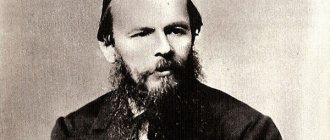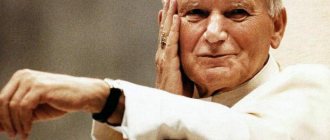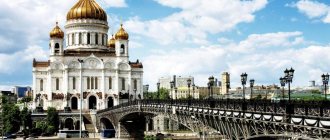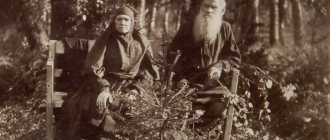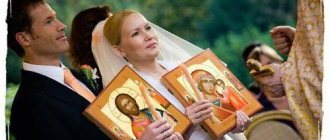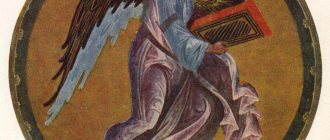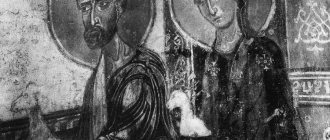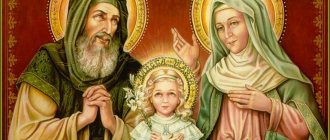In the numerous paintings of the Moscow Assumption Cathedral, the frescoes “Seven Sleeping Youths of Ephesus”, “Adoration of the Magi”, “Forty Martyrs of Sebaste”, “Praise to the Mother of God”, as well as figures of saints on the pre-altar wall of the cathedral, attract attention with their originality. All these works are too characteristic to be created by an icon painter who only blindly followed the Byzantine canon of iconography. The master's brush is clearly visible here. Yes, the frescoes were created during the period when Raphael, Durer, Botticelli and Leonardo lived and worked in Europe, because church fine art in Rus' did not know the Renaissance. But Dionysius the icon painter - the creator of the amazing paintings of the Assumption Cathedral in Moscow - still broke out of the “Procrustean bed” of the canon. His figures are not dead static, they are graceful, with an elongated silhouette, they float. Therefore, many foreign art critics call this isographer a “Russian mannerist.”
Biography
Presumably the icon painter Dionysius was born around 1440; there is no more exact date of his birth. But it is known for certain that his contemporaries called him a “cunning and graceful” icon painter, highly appreciating his talent and ability to notice bright details in his works. The works of the hero of our article were valued on a par with the works of another famous master - Andrei Rublev, and this is perhaps the highest rating that an icon painter can deserve. At the same time, Dionysius did not come from the so-called “simpletons”, like most artists of that time. He belonged to the rather noble class of boyars; his parents were from the Kvashnin family.
Very little is known about the biography of the icon painter Dionysius. The first major project in which he participated was the painting of the Nativity of the Mother of God Cathedral, located on the territory of the Pafnutievo Borovsky Monastery.
Comparing the icon painter Dionysius with Rublev, today many note that by the end of the 19th century the name of the former was practically forgotten; some superficial researchers even confused his name with Dionysius Glushitsky, who belonged to an earlier generation of icon painters.
Communication with Pafnuty Borovsky
While working in the monastery, Dionysius still found its founder Paphnutius Borovsky, an Orthodox saint, whose monastic feat lasted for 63 years. According to the legend describing the short biography of the icon painter Dionysius, he twice experienced the miraculous power of his prayers.
First, the monk healed the hero of our article when his legs hurt badly for an unknown reason, and then when he fell into illness, violating the commandment established by Paphnutius himself. She obliged everyone who was on the territory of the monastery not to bring meat food into the monastery. Laymen were allowed to eat meat, but only outside the monastery. Dionysius dared to break this rule.
Apparently, he simply forgot about it because he was very carried away and absorbed in his work. But as soon as he swallowed the very first piece of food forbidden on the territory of this monastery, he immediately remembered everything. Briefly describing the icon painter Dionysius, it should be noted that he was sincerely worried about what happened. His body immediately became covered with a rash, only Paphnutius, by forgiving him and reading prayers, was able to help overcome this illness.
see also
- Pseudo-Dionysius the Areopagite is an unknown author of a collection (corpus) of theological works in Greek, which in the Middle Ages received the name “Areopagitik”.
- Dionysius's comrades - African martyrs.
- Dionysia is one of the main festivals in Ancient Greece.
- Dionysus is the ancient Greek god of wine.
- Denis is a modern derivative form of the name Dionysius.
- Dénes is the Hungarian form of Dionysius
| A list of meanings of a word or phrase with links to relevant articles. If you came here from the text of another Wikipedia article, please go back and update the link so that it points to the correct article. |
__DISAMBIG__
Works of the icon painter
The earliest work of the icon painter Dionysius known to us is precisely the painting of the cathedral in the Pafnutievo Borovsky Monastery. The hero of our article worked on it for about ten years, from approximately 1467 to 1477.
In 1481, the artel, headed by Dionysius, received the right to paint the Assumption Church in the capital. This is one of the master's most famous works. If you have not seen them in person, you can appreciate their beauty at least from the photo. The icon painter Dionysius worked together with assistants; the chronicle of that period reports that they were “Priest Timofey, Konya and Yarets.”
After 1486, Dionysius worked in the Joseph-Volokolamsk monastery. There he painted icons for the cathedral church dedicated to the Dormition of the Mother of God. By that time, he had finally established himself at the head of the painting artel.
Nicholas the Wonderworker. Fresco of the Church of the Nativity of the Virgin Mary at Ferapontov Monastery
(Beginning, ) Dionysius is the third significant figure who completes Russian icon painting of the Golden Age. The century that began with the frescoes and icons of the frantic Byzantine and philosopher Theophan the Greek, continued in the brilliant, spiritual works of the Zvenigorod monk Andrei Rublev and ended with the picturesque frescoes of unearthly beauty of the Nativity Church of the Ferapontov Monastery of the layman Dionysius.
All three worked in the spirit of the hesychast tradition, but embodied it in different ways: Theophan - in the stern and formidable face of the Lord Pantocrator, St. Andrew - in the kind and merciful Savior, Dionysius - in the unearthly beauty of a man who acquired the Holy Spirit through intelligent work. The iconography of that time is a unique contribution of the Russian Orthodox Church to the dogmatic disputes that flared up in the 14th century in Byzantium between supporters and opponents of hesychasm and St. Gregory Palamas, who defends the uncreated light of Tabor.
Dionysius, although he was a layman and, like everyone else, made many mistakes, he knew how to pray and all his icons, especially the last frescoes, are the result of smart work, prayerful concentration and the wisdom of a person completing his earthly path. The painting of the haram of the Ferapontov Monastery crowns the long-term work of the icon painter and reveals the victory of the Holy Spirit over fallen human nature, the final point of all ascetic labors, the fruit of humility and grace.
The Virgin Mary on the throne. Fresco from the Ferapontovsky Monastery
Hence the lightness and weightlessness of all the figures, their serenity and aspiration towards eternity, the mystical cabbage roll in which they exist. Byzantium theologized with words, Russia with images. More is known about Dionysius than about Theophanes and St. Andrew, although the years of birth and death of the master are also blurred.
He was born somewhere between 1430-1440, and died between 1502-1508. Coming from a noble and wealthy boyar family of the Kvashnins, Dionysius had rich and influential patrons throughout his life. Having started studying icon painting early, he received his first major order for about thirty years: to participate in the painting of the Church of the Nativity of the Virgin Mary in the rich Pafnutievo-Borovsky Monastery.
His name was first mentioned in the life of the founder of this monastery, the Monk Paphnutius, who left memories of the wonderful masters Mitrofan and his student Dionysius, who painted the Nativity Cathedral in the monastery with wonderful frescoes. Almost nothing is known about Elder Mitrofan, but it can be assumed that it was he who became Dionysius’ confessor and mentor in smart work.
Our Lady "Hodegetria". Icon of Dionysius
The time in which Dionysius lived and worked was the time of the formation and rise of the Russian state. It was based on the Byzantine idea of the state as a divinely established institution on earth, a part of the Kingdom of Heaven, the head of which is God’s anointed. And the state must live according to divine laws. Accordingly, the improvement of the Russian state should begin with the construction of churches.
This was a time when the church gravitated towards rich and luxurious decorations, the aestheticization of all aspects of church life, from services and chants to the interiors of cathedrals and temples. That was the time of the Josephites, followers of Joseph Volotsky, the ideologist of strong church power, the so-called party of “acquisitors”, who accepted large donations for churches and monasteries, and advocated for the church to have as much assigned land, peasants and other wealth as possible.
The strict ascetic hesychast Nil Sorsky and the Monk Maxim the Greek fought against this party, but most clergy were guided by the “money-grubbers” who emerged victorious in this struggle. Ivan III was also a supporter of this party, putting a lot of effort and money into improving Moscow as the modern capital of a young and fast-growing Christian state, in accordance with the aesthetic ideal of the Josephite money-grubbers.
Icon of Metropolitan Alexy with life
The arrangement began with the Kremlin, where the cathedral in honor of the Dormition of the Virgin Mary had long been built, but three years after the start of construction, it collapsed due to low-quality lime. Then they invited the Italian architect Aristotle Fioravanti, who four years later built a wonderful temple on the same site, the like of which had never been seen in Russia. Now it was necessary to improve it inside.
By that time, Dionysius had already firmly taken the place of one of the best icon painters; he was already over forty, and had more than one painted temple under his belt. A favorite of the sovereign and leader of money-grubbing Joseph of Volotsky, for whom he painted more than eighty icons, Dionysius represented the official ideology. His style and compositions tended toward solemnity and pomp; festivity and pomp corresponded to the aesthetic ideal of the time. This is probably why he is called a Russian mannerist and the first painter.
Dionysius is commissioned to paint icons for the most important rows of the iconostasis: Deesis, festive and prophetic. It is believed that his brush belongs to the icon of the central row of the iconostasis - the Deesis. The Deesis series turned out to be wonderful and the icon painter was awarded the title of “excellent master” and he became the head of the Moscow school of icon painting.
"Crucifixion" Icon of Dionysius
For the Assumption Cathedral, Dionysius will paint two wonderful icons of Metropolitan Peter and Metropolitan Alexy with hagiographic stamps along the edge. They surround the images of saints like a wreath. The saints themselves look like two pillars established on earth to set an example for the living. In general, Dionysius painted a lot of icons, which no one had done before.
Previously, icons were painted for some occasion or for holidays. Dionysius painted icons so that people would see models in front of them that should be imitated. At the same time, the master painted the image of the Mother of God “Hodegetria” for the Ascension Monastery of the Kremlin; more precisely, he restored the icon that had once been brought from Byzantium, burnt during a fire.
Against a light background, the royal Mother of God reveals the Infant God to the world, pointing to him as the Path and Life. Solemnity and severity create the majesty of the image of the Virgin Mary. Another famous icon painted for the Pavlo-Obnorsky Monastery is called “The Crucifixion,” made for the festive row of the iconostasis. The center of the icon is a very elongated vertical cross on which the Savior is crucified.
Icon of Dionysius “Descent into Hell” (Resurrection - Anastasis)
His head is drooping like a withered flower, his hands are like outstretched stems, his body is curved, the figures of John the Evangelist, the Virgin Mary and women silently standing on the sides of the cross create a mood of solemnity and sadness at the same time. Such a Crucifixion is more like a breakthrough into Eternity, into Life - through the Cross, a symbol of victory over death. Here the Savior seems to be hovering above the earth, no longer belonging to it, because... He has already completed his mission.
Another of the most famous icons of Dionysius is “The Descent into Hell,” also painted for the festive row of the iconostasis. All surviving icons of the master are in various museums and art galleries. They are very different from Ferapontov’s frescoes, first of all, in their color saturation. The icon painter seems to be sculpting the figures of saints with multi-layered layers of paints, which as a result become rich and dense.
The frescoes of the Ferapontov Monastery, crowning the work of the icon painter, are made in a completely different style. The frescoes date back to 1502-1503 (a record of the dates of painting has been preserved in the temple). Since this northern monastery was poor and then completely abandoned, the frescoes were never renewed and remained as they were created by the great master more than five hundred years ago. The monastery later became famous for becoming the place of imprisonment of the disgraced Patriarch Nikon (1666).
Painting of the portal of the Church of the Nativity of the Virgin Mary at the Ferapontov Monastery
Dionysius created the frescoes together with his sons and several other assistants. The icon painter was already over sixty; he knew that he did not have long to live. Therefore, we can consider that this is a kind of testament and the last hymn to the Mother of God, whose churches he painted throughout his life. Here everything breathes Eternity and there is no place for death. There is not even an icon of the Assumption, although the temple is dedicated to the Mother of God.
The entire ensemble is made in blue, the color of the Most Pure One, but at the same time the color of Heaven, Eternity and mysticism. There are no bright colors here like those we see on the icons. All colors are muted and luminous, as if permeated with the Favorian light, which Gregory Palamas spoke about. He spoke about the Virgin Mary as the border between the Divine nature and the human. This is how Dionysius paints his frescoes, in which figures float between heaven and earth.
The icon painter takes the ancient Byzantine text “Akathist” in honor of the Mother of God, written by Roman the Sweet Singer, as the basis for the theological program for painting the temple. The akathist is supplemented with the image of the famous church hymn in honor of the Most Pure One “He rejoices in You...”, as well as with the scenes of the Intercession and the Council of the Virgin Mary. This entire monumental monument-fresco is a Praise to the Mother of God, Who was always revered by the Russian people above the Savior. The Trinity and all other dogmatic truths are not as clear to the people as the image of Motherhood, Virginity and eternal Femininity.
Frescoes of the Church of the Nativity of the Virgin Mary of the Ferapontov Monastery
The idea of love, compassion, mercy, beauty and tenderness merged here into a single image of the feminine principle, embodied in the theological tradition in the idea of Sophia. Without Her, life in all its fullness and diversity is impossible. The entire palette of Dionysius corresponds to the idea of Femininity: delicate, translucent, permeated with white light, personifying purity, purity and Divinity.
The luminosity of the palette is created through the active use of white, present in every color. It is white that makes other colors soft and enlightened, as if transformed by the Holy Spirit. Due to this, the figures seem weightless, which is enhanced by their image on a blue background. The sophistication and beauty of Dionysius's frescoes, harmony and silence, musicality and smoothness of lines make the temple elegant and solemn, foreshadowing the beginning of the end of Russian icon painting of the Golden Age.
Tina Guy
Interesting? Share information!
Murals of the Cathedral of the Nativity of the Virgin Mary
Among the latest works, which we can confidently say that they belong to the brush of Dionysius, we can note the wall paintings of the iconostasis in the Cathedral of the Nativity of the Virgin Mary on the territory of the Ferapontov Monastery. He carried them out together with his sons, who often helped their father when they grew up.
The work of the icon painter Dionysius includes dozens of famous works. Among the most famous, researchers name the everyday icons of Metropolitans Alexei and Peter, painted in 1462-1472, “Our Lady Hodegetria” from 1482, “The Baptism of the Lord” from 1500, “The Crucifixion” and “The Savior in Power” of the same period, “The Descent into hell".
The exact date of Dionysius's death has not been established. Various sources indicate 1503, 1508, or even after the 1520s.
The icons of the icon painter Dionysius are valued not only in Russia, but throughout the world. That is why 2002 was declared the Year of Dionysius by UNESCO.
Excerpt characterizing Dionysius
Princess Marya vividly imagined the position of m lle Bourienne, who had recently been distant from her society, but at the same time dependent on her and living in someone else’s house. And she felt sorry for her. She looked at her meekly questioningly and extended her hand. M lle Bourienne immediately began to cry, began to kiss her hand and talk about the grief that befell the princess, making herself a participant in this grief. She said that the only consolation in her grief was that the princess allowed her to share it with her. She said that all former misunderstandings should be destroyed before great grief, that she felt pure in front of everyone and that from there he could see her love and gratitude. The princess listened to her, not understanding her words, but occasionally looking at her and listening to the sounds of her voice. “Your situation is doubly terrible, dear princess,” said m lle Bourienne, after a pause. – I understand that you could not and cannot think about yourself; but I am obliged to do this with my love for you... Was Alpatych with you? Did he talk to you about leaving? – she asked. Princess Marya did not answer. She did not understand where and who was supposed to go. “Was it possible to do anything now, to think about anything? Doesn't it matter? She didn't answer. “Do you know, chere Marie,” said m lle Bourienne, “do you know that we are in danger, that we are surrounded by the French; It's dangerous to travel now. If we go, we will almost certainly be captured, and God knows... Princess Marya looked at her friend, not understanding what she was saying. “Oh, if only someone knew how much I don’t care now,” she said. - Of course, I would never want to leave him... Alpatych told me something about leaving... Talk to him, I can’t do anything and don’t want anything... - I talked to him. He hopes that we will have time to leave tomorrow; but I think that now it would be better to stay here,” said m lle Bourienne. - Because, you see, chere Marie, falling into the hands of soldiers or rioting men on the road would be terrible. - M lle Bourienne took out from her reticule an announcement on a non-Russian extraordinary paper from the French General Rameau that residents should not leave their homes, that they would be given due protection by the French authorities, and handed it to the princess. “I think it is better to contact this general,” said M lle Bourienne, “and I am sure that you will be shown due respect.” Princess Marya read the paper, and dry sobs shook her face. -Who did you get this through? - she said. “They probably found out that I’m French by name,” said m lle Bourienne, blushing. Princess Marya, with a paper in her hand, stood up from the window and, with a pale face, left the room and went to the former office of Prince Andrei. “Dunyasha, call Alpatych, Dronushka, someone to me,” said Princess Marya, “and tell Amalya Karlovna not to come to me,” she added, hearing the voice of m lle Bourienne. - Hurry up and go! Go quickly! - said Princess Marya, horrified by the thought that she could remain in the power of the French. “So that Prince Andrei knows that she is in the power of the French! So that she, the daughter of Prince Nikolai Andreich Bolkonsky, asks Mr. General Rameau to provide her with protection and enjoy his benefits! “This thought terrified her, made her shudder, blush and feel attacks of anger and pride that she had not yet experienced. Everything that was difficult and, most importantly, offensive in her position, was vividly imagined to her. “They, the French, will settle in this house; Mr. General Rameau will occupy the office of Prince Andrei; It will be fun to sort through and read his letters and papers. M lle Bourienne lui fera les honneurs de Bogucharovo. [Mademoiselle Bourien will receive him with honors in Bogucharovo.] They will give me a room out of mercy; soldiers will destroy their father's fresh grave to remove crosses and stars from him; they will tell me about victories over the Russians, they will feign sympathy for my grief... - Princess Marya thought not with her own thoughts, but feeling obligated to think for herself with the thoughts of her father and brother. For her personally, it didn’t matter where she stayed and no matter what happened to her; but at the same time she felt like a representative of her late father and Prince Andrei. She involuntarily thought with their thoughts and felt them with their feelings. Whatever they would say, whatever they would do now, that is what she felt necessary to do. She went to Prince Andrei’s office and, trying to penetrate his thoughts, pondered her situation. The demands of life, which she considered destroyed with the death of her father, suddenly arose with a new, still unknown force before Princess Marya and overwhelmed her. Excited, red-faced, she walked around the room, demanding first Alpatych, then Mikhail Ivanovich, then Tikhon, then Dron. Dunyasha, the nanny and all the girls could not say anything about the extent to which what M lle Bourienne announced was fair. Alpatych was not at home: he had gone to see his superiors. The summoned Mikhail Ivanovich, the architect, who came to Princess Marya with sleepy eyes, could not say anything to her. With exactly the same smile of agreement with which he had been accustomed for fifteen years to respond, without expressing his opinion, to the old prince’s appeals, he answered Princess Marya’s questions, so that nothing definite could be deduced from his answers. The summoned old valet Tikhon, with a sunken and haggard face, bearing the imprint of incurable grief, answered “I listen with” to all the questions of Princess Marya and could hardly restrain himself from sobbing, looking at her. Finally, the elder Dron entered the room and, bowing low to the princess, stopped at the lintel. Princess Marya walked around the room and stopped opposite him. “Dronushka,” said Princess Marya, who saw in him an undoubted friend, the same Dronushka who, from his annual trip to the fair in Vyazma, brought her his special gingerbread every time and served her with a smile. “Dronushka, now, after our misfortune,” she began and fell silent, unable to speak further. “We all walk under God,” he said with a sigh. They were silent. - Dronushka, Alpatych has gone somewhere, I have no one to turn to. Is it true that they tell me that I can’t leave? “Why don’t you go, your Excellency, you can go,” said Dron. “They told me it was dangerous from the enemy.” Darling, I can’t do anything, I don’t understand anything, there’s no one with me. I definitely want to go at night or early tomorrow morning. – The drone was silent. He glanced at Princess Marya from under his brows. “There are no horses,” he said, “I told Yakov Alpatych too.” - Why not? - said the princess. “It’s all from God’s punishment,” said Dron. “Which horses there were were dismantled for use by the troops, and which ones died, what year it is today.” It’s not like feeding the horses, but making sure we don’t die of hunger ourselves! And they sit like that for three days without eating. There is nothing, they are completely ruined. Princess Marya listened carefully to what he told her. - Are the men ruined? Do they have no bread? – she asked. “They’re dying of starvation,” said Dron, “not like the carts...” “Why didn’t you say so, Dronushka?” Can't you help? I will do everything I can... - It was strange for Princess Marya to think that now, at such a moment, when such grief filled her soul, there could be rich and poor people and that the rich could not help the poor. She vaguely knew and heard that there was master's bread and that it was given to the peasants. She also knew that neither her brother nor her father would refuse the needs of the peasants; she was only afraid of somehow making a mistake in her words about this distribution of bread to the peasants, which she wanted to dispose of. She was glad that she was presented with an excuse for concern, one for which she was not ashamed to forget her grief. She began asking Dronushka for details about the needs of the men and about what was lordly in Bogucharovo. – After all, we have the master’s bread, brother? – she asked. “The master’s bread is all intact,” Dron said proudly, “our prince did not order it to be sold.” “Give him to the peasants, give him everything they need: I give you permission in the name of my brother,” said Princess Marya. The drone said nothing and took a deep breath. “You give them this bread if it is enough for them.” Give everything away. I command you in the name of my brother, and tell them: what is ours is also theirs. We will spare nothing for them. So tell me. The drone looked intently at the princess while she spoke. “Dismiss me, mother, for God’s sake, tell me to accept the keys,” he said. “I served for twenty-three years, I didn’t do anything bad; leave me alone, for God's sake.
Lost works
Researchers greatly regret the fact that many famous works of Dionysius have not survived to our time. For example, we are talking about the Last Judgment icon. This fresco was located on the western wall of the Cathedral of the Nativity of the Virgin. Unfortunately, the figure of Jesus Christ, which was depicted on the fresco, was lost over time due to the desire of the later owners of the cathedral to make an additional window.
Significant for Dionysius was his acquaintance with the Monk Joseph of Volotsky, which took place in the Pafnutiev Monastery. Having founded his monastery, Joseph persuaded the hero of our article to paint it too. Thus, in the inventory of the monastery property, which dates back to 1545, it is stated that Dionysius created a large deesis for the cathedral church, that is, a group of icons in the center of which Jesus Christ is depicted, and on the sides of him are John the Baptist and the Mother of God. The master also created prophetic and festive rows, decorated the royal doors, depicting on them the traditional biblical plot of the Annunciation of the Blessed Virgin Mary and the four evangelists. In total, according to the same inventory, 87 icons remained in the monastery, painted by Dionysius or the workers of his artel.
Surviving works of Dionysius in the capital
If the master’s icons were mainly transferred from the Assumption Cathedral to museum exhibitions, then the frescoes can still be seen on the walls of this Kremlin temple. More than twenty wall images of the master have survived. Among the above-mentioned “Adoration of the Magi”, “Praise of the Mother of God” and other works, attention should be paid to the fresco “Alexey, Man of God”. Researchers believe that this image is a self-portrait of the artist. You cannot pass by the icon of Dionysius, depicting the Last Judgment. Painted in the atmosphere of eschatological expectations of 1492, this picture is full of internal tension. But the multi-tiered composition, despite its complexity and overload with inscriptions, looks light and elegant. Horror gives way to glee: translucent images of angels trample the black figures of demons.
Frescoes by icon painter
Many frescoes of Dionysius have not survived either. For example, those that he painted for the Pafnutiev Monastery, as well as icons for Joseph of Volotsky himself. It is now impossible to see the iconostasis of the Assumption Cathedral in the capital's Kremlin, painted by Dionysius. He specially created images for him.
Only a few works that have survived to this day can be confidently attributed to icons painted by Dionysius. First of all, these are the hagiographic icons of Saints Alexy and Peter.
Iconostasis of the Assumption Monastery in the Kremlin
The collaboration between the art cartel led by Dionysius and the Moscow authorities did not end there. In 1481, at the invitation of Metropolitan Vassian, artists began work on the iconostasis in the same cathedral. Like the frescoes of Dionysius, his works on a wooden board in oil surprise the viewer with their coloristic harmony. But if in painting on wet plaster the color palette looks surprisingly delicate, translucent, reminiscent of watercolor, then in icons the artist resorts to an innovative technique of “color enhancement,” which is his own “know-how.” He puts a stroke of one tone on top of another, which makes the image acquire volume and convexity. At the altar gates, Dionysius the icon painter performed the most important part - the Deesis rite. Two works - the lives of Metropolitans Peter and Alexy - are striking examples of his creativity. In 1482, the artist also “restored” the Byzantine icon of the Mother of God “Hodegetria”, damaged during a fire, for the Ascension Monastery in Moscow.
Northern period of creativity
It is not possible to accurately describe the biography of Dionysius, since practically no documentary evidence has survived to this day. It is safe to say that after completing his work in the Assumption Cathedral, he moved to live in Moscow for some time. There he had a large number of all kinds of orders.
In Moscow, Dionysius was already working together with his sons, who provided him with significant help and support. At that time, the hero of our article became close friends with the Monk Joseph of Volotsky, who compiled the famous “Message to the Icon Painter” for him.
The significance of Dionysius for Russian iconography
UNESCO dedicated the year 2002 to Dionysius the icon painter. The significance of this master’s creativity is difficult to overestimate. He developed the ideas of his famous predecessor, Andrei Rublev, and at the same time introduced many features that were unique to him. For example, color enhancement and abundant use of white began to be used by other masters after Dionysius. Also noteworthy is his manner of depicting figures with deliberately elongated limbs, which among art critics brought him the fame of a mannerist. The frescoes and icons of Dionysius surprise with their confident designs, translucent coloring, plasticity and perfection of compositions.
"Belozersky" period
Acquaintance and communication with the Monk Joseph, who at that time was considered one of the most authoritative people in theological terms, gave Dionysius a lot. This is especially noticeable in his works, which researchers attribute to the “Belozersky” period. According to art historians, its beginning can be dated back to 1490, but the latest of the icons that have come down to us are considered to be the so-called “northern letters” of Dionysius, which date back to 1500. The icon painter painted them for the Pavlo-Obnorsky Monastery, which is located near Vologda.
In 1502, Dionysius created frescoes for the Cathedral of the Nativity of the Virgin Mary, located on the territory of the Ferapontov Monastery. His sons help him with this. But the very next year is officially considered by many to be the year of his death, although there is reason to believe that he lived much longer.
Another interesting point about the fate of Dionysius. It is believed that shortly before his death he took monastic vows, spending the remains of his days in the monastery, as they said in those distant times, in contemplation of God and silence.
Today we can say with confidence that Dionysius was one of the most outstanding personalities of that time period.
"Crucifixion"
One of the most famous icons of Dionysius is called “The Crucifixion”. It dates back to 1500. It was written for the so-called festive row of the iconostasis of the Trinity Cathedral, which was located in the Pavlo-Obnorsky Monastery. This is a famous male Orthodox monastery in the Vologda region. It was founded in 1414 by a student of Sergius of Radonezh and is considered one of the largest and most ancient monasteries in the Russian north.
Researchers highly value this icon, noting that it depicts a simultaneously comforting and mournful image, which is almost completely devoid of naturalism, which can be observed in the works of many Western masters of that and later periods.
In the Ancient World
- Dionysius was the king of one of the Indo-Greek kingdoms in Punjab.
- Dionysius of Halicarnassus is an ancient Greek historian and rhetorician of the second half of the 1st century BC. e.
- Dionysius of Heraclea - tyrant of Heraclea Pontus.
- Dionysius of Heraclea - Stoic philosopher, later Cyrenaic.
- Dionysius of Cyrene was a Stoic philosopher and mathematician.
- Dionysius the Younger - Syracusan tyrant, son of Dionysius the Elder.
- Dionysius Periegetes (2nd century) - ancient Greek geographer from Alexandria.
- Dionysius the Elder - Tyrant of Syracuse.
- Dionysius of Phocaeans was an ancient Greek general who commanded the Ionian fleet at the Battle of Lada.
- Dionysius of Thracia was a Greek grammarian from Alexandria, a student of Aristarchus.
- Flavius Dionysius was a Roman politician of the first half of the 4th century.
Sons of Dionysius
His sons, whose names were Feodosius and Vladimir, provided serious assistance and support to their father. All painting at the turn of the 15th-16th centuries is characterized by the work of the hero of our article and his two sons. It is interesting that, unlike many of his predecessors, who were themselves monks, working in monasteries, Dionysius remained a layman. He may have died in this status, although most biographers believe that he did take monastic vows before his death.
Dionysius himself taught his sons the unsurpassed art of icon painting, and together they worked in different parts of Rus'. For example, together they painted the stone Church of the Assumption of the Mother of God in the Joseph-Volokolomsky Monastery, founded in 1484; it was consecrated the following year. That same summer, Dionysius painted it together with his sons.
An active successor to his father’s work was his youngest son Theodosius, who in 1508 was invited by Grand Duke Vasily III to paint the Annunciation Cathedral in the Moscow Kremlin. There one could see the faces of St. George the Victorious, Dmitry of Thessalonica, Byzantine empresses and emperors. All this symbolized the continuity of power of the Moscow princes.
Theodosius also became famous as a designer of church books on biblical subjects. It is with his name that many associate the appearance of the old printed ornament. But nothing is known about the work of Dionysius’ eldest son Vladimir. According to the most common version, he took monastic vows under the name Vassian.
Artist and era
To fully understand the work of Dionysius, you need to study at least a little the era in which he lived. The universal aspiration and at the same time horror of the Orthodox world of that time was the expectation of the Apocalypse. The end of the world was supposed to come, according to the clergy, in 1492. Great changes also took place in the political life of Rus'. In 1480, a victory was won on the Ugra, which marked the fall of the Mongol yoke. The Moscow prince captured the lands of Pskov, Novgorod and Tver. Ivan III decided to create a centralized state. Court scribes began to trace the genealogy of the royal family through the Byzantine basileus Palaiologos from the Roman emperor Augustus. Therefore, the modest size and decoration of Moscow churches no longer suited Ivan III. He started large-scale construction to turn Moscow into the “Third Rome”. And in this situation, architects and painters were in great demand.

